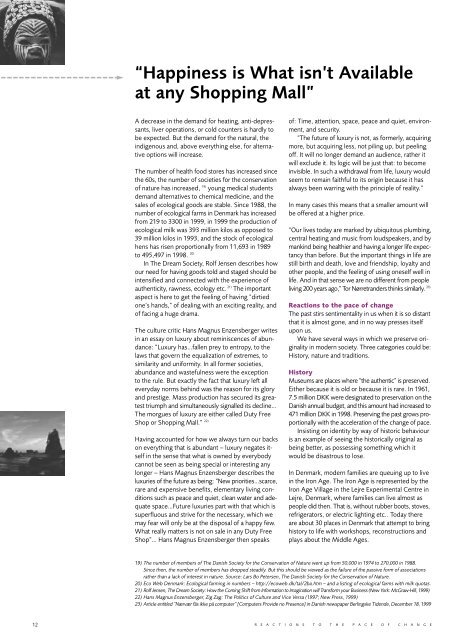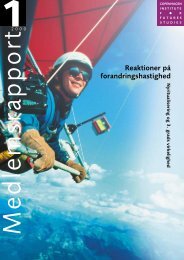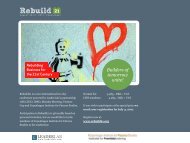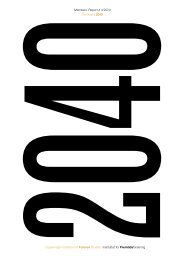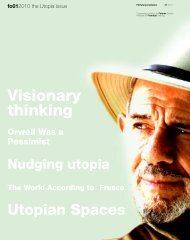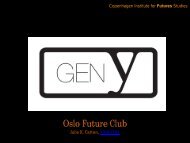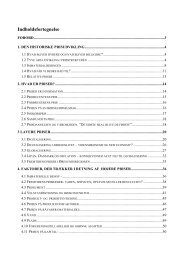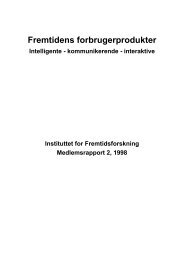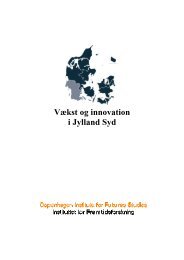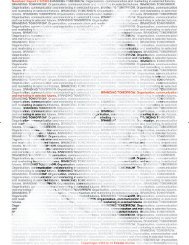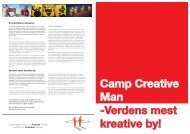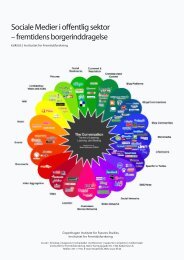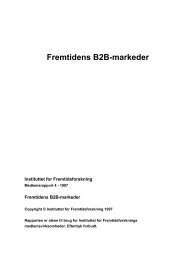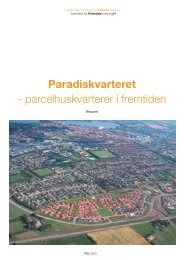Reactions to the Pace of Change
Reactions to the Pace of Change
Reactions to the Pace of Change
Create successful ePaper yourself
Turn your PDF publications into a flip-book with our unique Google optimized e-Paper software.
“Happiness is What isn’t Availableat any Shopping Mall”A decrease in <strong>the</strong> demand for heating, anti-depressants,liver operations, or cold counters is hardly <strong>to</strong>be expected. But <strong>the</strong> demand for <strong>the</strong> natural, <strong>the</strong>indigenous and, above everything else, for alternativeoptions will increase.The number <strong>of</strong> health food s<strong>to</strong>res has increased since<strong>the</strong> 60s, <strong>the</strong> number <strong>of</strong> societies for <strong>the</strong> conservation<strong>of</strong> nature has increased, 19) young medical studentsdemand alternatives <strong>to</strong> chemical medicine, and <strong>the</strong>sales <strong>of</strong> ecological goods are stable. Since 1988, <strong>the</strong>number <strong>of</strong> ecological farms in Denmark has increasedfrom 219 <strong>to</strong> 3300 in 1999, in 1999 <strong>the</strong> production <strong>of</strong>ecological milk was 393 million kilos as opposed <strong>to</strong>39 million kilos in 1993, and <strong>the</strong> s<strong>to</strong>ck <strong>of</strong> ecologicalhens has risen proportionally from 11,693 in 1989<strong>to</strong> 495,497 in 1998. 20)In The Dream Society, Rolf Jensen describes howour need for having goods <strong>to</strong>ld and staged should beintensified and connected with <strong>the</strong> experience <strong>of</strong>au<strong>the</strong>nticity, rawness, ecology etc. 21) The importantaspect is here <strong>to</strong> get <strong>the</strong> feeling <strong>of</strong> having “dirtiedone’s hands,” <strong>of</strong> dealing with an exciting reality, and<strong>of</strong> facing a huge drama.The culture critic Hans Magnus Enzensberger writesin an essay on luxury about reminiscences <strong>of</strong> abundance:“Luxury has…fallen prey <strong>to</strong> entropy, <strong>to</strong> <strong>the</strong>laws that govern <strong>the</strong> equalization <strong>of</strong> extremes, <strong>to</strong>similarity and uniformity. In all former societies,abundance and wastefulness were <strong>the</strong> exception<strong>to</strong> <strong>the</strong> rule. But exactly <strong>the</strong> fact that luxury left alleveryday norms behind was <strong>the</strong> reason for its gloryand prestige. Mass production has secured its greatesttriumph and simultaneously signalled its decline…The morgues <strong>of</strong> luxury are ei<strong>the</strong>r called Duty FreeShop or Shopping Mall.” 22)Having accounted for how we always turn our backson everything that is abundant – luxury negates itselfin <strong>the</strong> sense that what is owned by everybodycannot be seen as being special or interesting anylonger – Hans Magnus Enzensberger describes <strong>the</strong>luxuries <strong>of</strong> <strong>the</strong> future as being: “New priorities…scarce,rare and expensive benefits, elementary living conditionssuch as peace and quiet, clean water and adequatespace…Future luxuries part with that which issuperfluous and strive for <strong>the</strong> necessary, which wemay fear will only be at <strong>the</strong> disposal <strong>of</strong> a happy few.What really matters is not on sale in any Duty FreeShop”… Hans Magnus Enzensberger <strong>the</strong>n speaks<strong>of</strong>: Time, attention, space, peace and quiet, environment,and security.“The future <strong>of</strong> luxury is not, as formerly, acquiringmore, but acquiring less, not piling up, but peeling<strong>of</strong>f. It will no longer demand an audience, ra<strong>the</strong>r itwill exclude it. Its logic will be just that: <strong>to</strong> becomeinvisible. In such a withdrawal from life, luxury wouldseem <strong>to</strong> remain faithful <strong>to</strong> its origin because it hasalways been warring with <strong>the</strong> principle <strong>of</strong> reality.”In many cases this means that a smaller amount willbe <strong>of</strong>fered at a higher price.“Our lives <strong>to</strong>day are marked by ubiqui<strong>to</strong>us plumbing,central heating and music from loudspeakers, and bymankind being healthier and having a longer life expectancythan before. But <strong>the</strong> important things in life arestill birth and death, love and friendship, loyalty ando<strong>the</strong>r people, and <strong>the</strong> feeling <strong>of</strong> using oneself well inlife. And in that sense we are no different from peopleliving 200 years ago,” Tor Nørretranders thinks similarly. 23)<strong>Reactions</strong> <strong>to</strong> <strong>the</strong> pace <strong>of</strong> changeThe past stirs sentimentality in us when it is so distantthat it is almost gone, and in no way presses itselfupon us.We have several ways in which we preserve originalityin modern society. Three categories could be:His<strong>to</strong>ry, nature and traditions.His<strong>to</strong>ryMuseums are places where “<strong>the</strong> au<strong>the</strong>ntic” is preserved.Ei<strong>the</strong>r because it is old or because it is rare. In 1961,7.5 million DKK were designated <strong>to</strong> preservation on <strong>the</strong>Danish annual budget, and this amount had increased <strong>to</strong>471 million DKK in 1998. Preserving <strong>the</strong> past grows proportionallywith <strong>the</strong> acceleration <strong>of</strong> <strong>the</strong> change <strong>of</strong> pace.Insisting on identity by way <strong>of</strong> his<strong>to</strong>ric behaviouris an example <strong>of</strong> seeing <strong>the</strong> his<strong>to</strong>rically original asbeing better, as possessing something which itwould be disastrous <strong>to</strong> lose.In Denmark, modern families are queuing up <strong>to</strong> livein <strong>the</strong> Iron Age. The Iron Age is represented by <strong>the</strong>Iron Age Village in <strong>the</strong> Lejre Experimental Centre inLejre, Denmark, where families can live almost aspeople did <strong>the</strong>n. That is, without rubber boots, s<strong>to</strong>ves,refrigera<strong>to</strong>rs, or electric lighting etc.. Today <strong>the</strong>reare about 30 places in Denmark that attempt <strong>to</strong> bringhis<strong>to</strong>ry <strong>to</strong> life with workshops, reconstructions andplays about <strong>the</strong> Middle Ages.19) The number <strong>of</strong> members <strong>of</strong> The Danish Society for <strong>the</strong> Conservation <strong>of</strong> Nature went up from 50,000 in 1974 <strong>to</strong> 270,000 in 1988.Since <strong>the</strong>n, <strong>the</strong> number <strong>of</strong> members has dropped steadily. But this should be viewed as <strong>the</strong> failure <strong>of</strong> <strong>the</strong> passive form <strong>of</strong> associationsra<strong>the</strong>r than a lack <strong>of</strong> interest in nature. Source: Lars Bo Petersen, The Danish Society for <strong>the</strong> Conservation <strong>of</strong> Nature.20) Eco Web Denmark: Ecological farming in numbers – http://ecoweb.dk/tal/2ba.htm – and a listing <strong>of</strong> ecological farms with milk quotas.21) Rolf Jensen, The Dream Society: How <strong>the</strong> Coming Shift from Information <strong>to</strong> Imagination will Transform your Business (New York: McGraw-Hill, 1999)22) Hans Magnus Enzensberger, Zig Zag: The Politics <strong>of</strong> Culture and Vice Versa (1997; New Press, 1999)23) Article entitled “Nærvær fås ikke på computer” [Computers Provide no Presence] in Danish newspaper Berlingske Tidende, December 18, 199912 R E A C T I O N S T O T H E P A C E O F C H A N G E


